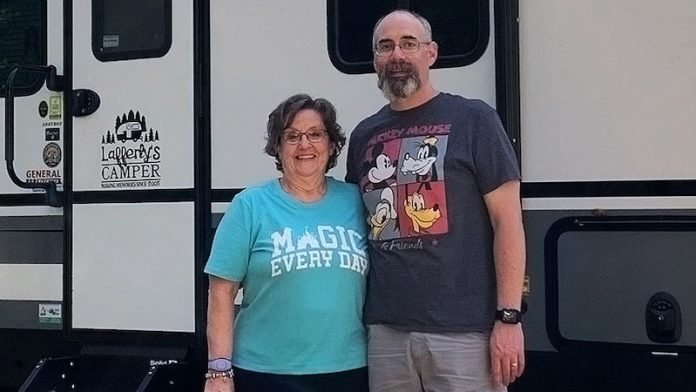
Carol Lafferty may have spent Christmas 2020 in a hospital bed, but she’s definitely “back in the game” and looking forward to a life of retirement and relaxation.
The 61-year-old underwent open-heart surgery to replace her bicuspid aortic valve and repair an aneurysm in her ascending aorta, conditions that might not have been discovered if not for a routine annual exam in October 2018.
“During the exam, the physician assistant asked me if I knew I had a heart murmur,” said Lafferty, a Linden, Michigan, resident and retired school teacher. “No one had ever mentioned that before.”
As a precautionary measure, an echocardiogram was ordered for Lafferty, who had no previous heart issues or family history.
Fully expecting to receive a positive report, she was surprised to find out she would need to follow up with a cardiologist. Her echocardiogram revealed a bicuspid aortic valve, responsible for the murmur.
Complications of a defective valve
A bicuspid valve is a condition that affects 1 to 2% of the population.
The genetic condition means that an individual’s aortic valve, through which the heart sends oxygen-rich blood to the body, has only two flaps (or “leaflets”) that open and close. A typical aortic valve has three.
Complications of bicuspid aortic valve disease include aortic stenosis (a narrowing or calcifying of the valve, preventing it from opening fully), aortic insufficiency (a leakage of the valve causing blood to flow backward), aortic aneurysm (a balloon-like bulge) and aortic dissection (a separation of the aorta’s inner layer).
All of these complications may be life-threatening.
“The cardiologist I saw near my home discussed my bicuspid valve with me but told me not to worry about it,” said Lafferty, who was experiencing symptoms that included fatigue, tightness in her chest and shortness of breath.
However, because she also had asthma, her symptoms were attributed to that. “He said I might need to have my bicuspid valve replaced in 10 years or so, but until then, I was ok.”
Following her instincts
Lafferty’s intuition told her otherwise. Her husband, Matt, agreed, “If you have a heart condition, I want you to go to the University of Michigan.”
Lafferty met with Michigan Medicine Frankel Cardiovascular Center cardiologist Peter Farrehi, M.D., in February 2019. During that visit, Farrehi also diagnosed an ascending aortic aneurysm measuring 4.7 cm.
The average aorta is approximately 2 centimeters, or slightly smaller than 1 inch. An aneurysm means that the diameter is 1.5 times larger than normal, or 3 centimeters, in the abdominal aorta.
Surgery is considered when an aneurysm grows to approximately 5.5 centimeters.
Individuals with an aortic aneurysm typically experience a “watchful waiting” period in which the aneurysm is closely monitored until it reaches a size where surgery may become necessary.
“Because there was no way of knowing how fast my aneurysm was growing, Dr. Farrehi wanted to monitor it for a year. I was to let him know if I was experiencing worsening symptoms,” said Lafferty.
“When I returned to U-M in November 2019 they found my bicuspid valve had become more calcified but still Dr. Farrehi wanted to monitor me and keep a watch on the valve and aneurysm,” said Lafferty.
Time to act
By the summer of 2020, Lafferty was experiencing worsening symptoms, including chest pain while working at her family-owned hardware store.
When the pain moved to her back and arms, she knew things were progressing. Farrehi called in thoracic surgeon Gorav Ailawadi, M.D., to consult.
“I had a zoom appointment with Dr. Ailawadi on December 7, 2020,” said Lafferty. “He reviewed all my scans and said, ‘OK, I think it’s time for surgery.’”
On December 21, 2020, Lafferty’s aortic valve and ascending aorta were replaced.
“We replaced her tricuspid valve with a bovine valve, which can last up to 15 years,” said Ailawadi. “With these surgeries, we consider the patient’s lifespan and how we can help avoid a future open-heart surgery.”
For Carol, it meant she would likely outlive her bovine valve, but would be a potential candidate for a transcatheter aortic valve replacement, also known as a TAVR, instead of another open-heart procedure.
During the surgery, Ailawadi also replaced the part of Lafferty’s aorta weakened by the aneurysm with a man-made fabric tube, known as a graft.
“The patient had a remarkable recovery and told us she could immediately feel the difference,” said Ailawadi.
“I really had hardly any pain after the surgery. My only issue was that I felt like I couldn’t expand my lungs or take a deep breath,” said Lafferty.
Back in the game
Today, she’s feeling great. “Looking back, it’s almost like a dream. I feel much stronger now.”
Lafferty and her husband aren’t wasting any time as they’ve both embraced retirement. The couple purchased a truck and recreational vehicle and are busy traveling the country.
“I’m absolutely happy,” she said as she looks forward to quality time with her family. “I’m mentally and physically back in the game now that my surgery is over and the cloud that was hanging over my head has lifted.”
Written by Carol Lafferty.
If you care about heart attack, please read studies about white bread that could increase the risk of heart attack, and this combo therapy can cut risk of heart attack and stroke by half.
For more information about heart health, please see recent studies about high blood pressure drugs that could increase heart failure risk, and results showing statin drugs can do double duty on heart disease and cancer.



